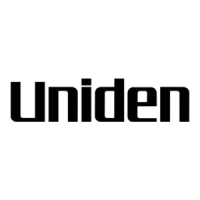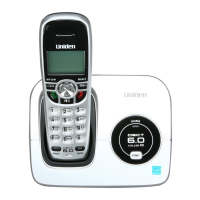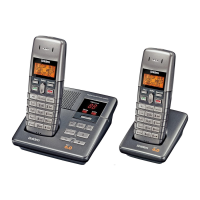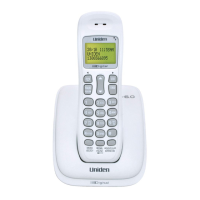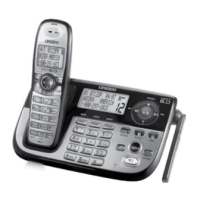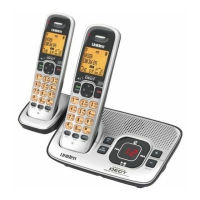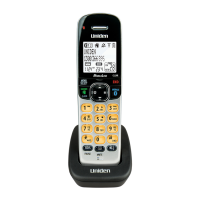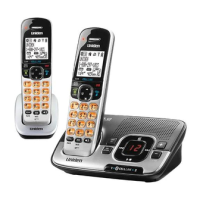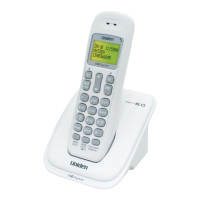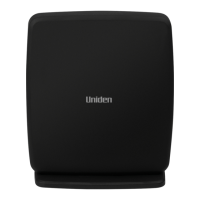Do you have a question about the Uniden DECT1580 and is the answer not in the manual?
| Type | DECT telephone |
|---|---|
| Answering machine | Yes |
| Phonebook capacity | 70 entries |
| Redial list capacity | 5 |
| Call list capacity phonebook | 30 |
| Backlight color | Yellow |
| Frequency band | 1.9 GHz |
| Mac compatibility | No |
| Product color | Black, Silver |
| Operating temperature (T-T) | 0 - 50 °C |
| Battery type | BT-1015 |
| Standby time | 168 h |
| Battery capacity | 650 mAh |
| Power supply type | AC/DC |
| Battery technology | Nickel-Cadmium (NiCd) |
| Power requirements | AC 120V@60Hz |
Guide for selecting an optimal placement for the phone base.
Instructions on how to install the rechargeable battery pack into the handset.
Steps for connecting the AC adapter to the base and charging cradle.
Procedure for charging the handset in the base cradle.
Guide on connecting the phone to the telephone wall jack.
Steps to verify the phone connection and hear a dial tone.
How to switch between tone and pulse dialing modes.
Overview of the phone's key features and capabilities.
Description of the functions and capabilities of the built-in answering system.
Explains the icons and information shown on the handset display.
Details on using the four-way key for navigation and feature access.
Guide to accessing and navigating the handset menu options.
Instructions for typing text using the handset keypad.
How to choose the display language for the handset menus.
Procedure for setting the current date and time on the phone.
Assigning unique ringtones to specific contacts in the phonebook.
Enabling or disabling audible feedback for key presses.
Steps for adding new names and numbers to the phonebook.
How to search for and locate entries within the phonebook.
Process for modifying saved phonebook entries.
Saving incoming call or redial numbers into the phonebook.
Removing a specific entry from the phonebook.
Renaming the handset display name.
Choosing different audible alerts for incoming calls.
Enabling automatic answering upon lifting the handset.
Allowing any key press to answer an incoming call.
Steps for initiating outgoing calls from the handset or speakerphone.
Procedures for receiving incoming calls.
Methods for ending a call.
Dialing numbers directly from the stored phonebook entries.
Using phonebook entries for sequence dialing of codes.
Accessing and viewing the list of incoming calls with identification.
Dialing a number directly from a saved Caller ID entry.
Setting up local area code for seven-digit dialing display.
Removing specific entries from the Caller ID list.
Quickly accessing and redialing recently dialed numbers.
Removing a specific number from the redial list.
Setting the audible alert volume for incoming calls.
Temporarily silencing the ringer for the current call.
Setting the listening volume for calls through the earpiece.
Setting the volume for calls using the handset speakerphone.
Modifying the sound quality of the earpiece audio.
Temporarily suspending an active call.
Setting up three-way calls involving multiple participants.
Moving an active call from one handset to another.
Preventing other handsets from interrupting an active call.
Communicating between handsets without using the phone line.
Temporarily disabling the microphone during a call.
Accessing and managing voice messages.
Creating a custom outgoing message for the answering system.
Switching between personal and pre-recorded greetings.
Removing a recorded personal greeting.
Choosing the language for system prompts and announcements.
Configuring how many times the phone rings before answering.
Setting message recording duration or disabling recording.
Enabling audible alerts for new messages.
Listening to callers leave messages in real-time.
Procedures to activate or deactivate the answering system.
Controlling the answering system remotely via the handset.
Listening to saved new and old messages.
Listening to callers as they leave messages.
Managing the answering system remotely via a touch-tone phone.
Connecting remotely to the answering system via phone.
Instructions for detaching the wall-mount bracket from the base.
Technical details and operating parameters of the phone.
Details on battery usage, lifespan, and charging.
Information on the low battery warning indicator and its meaning.
Procedure for cleaning handset and base charging contacts.
Effects of power outages on phone operation and protection measures.
A list of frequent problems and their potential solutions.
Tips for improving audio quality and clarity.
Troubleshooting steps for interference causing static or noise.
Guidance on using filters to reduce line interference.
Procedures for resetting the handset to resolve issues.
How to reset a handset when the original base is unavailable.
Adjusting line mode settings for multi-base or extension phone systems.
Information on what happens when the handset moves out of base range.
Steps to take if the phone is exposed to moisture or liquid.
Warnings and information regarding the care and disposal of Ni-Cd batteries.
General safety guidelines for using telephone equipment.
Information regarding FCC compliance and regulations.
Explains sources of radio interference and how to minimize it.
Industry Canada compliance information for terminal and radio equipment.

